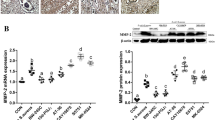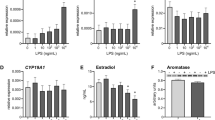Abstract
Endometrial epithelial cells play a key defensive role as part of the innate immune response of cow uterus. An association between risk of acquiring infectious diseases and increased levels of free fatty acids postpartum has been suggested, and the use of omega-3 fatty acids such as docosahexaenoic acid (DHA) has been proposed as a beneficial strategy to improve immunity and fertility. The goal of our study was to demonstrate the presence of free fatty acid (FFA)-1 and 4 receptors in endometrial cells and to investigate their role on DHA interference in lipopolysaccharide (LPS)-induced inflammatory endometrial activation. We demonstrated that the bovine endometrial (BEND) cells line and bovine endometrium express both FFA1 and FFA4 receptors. FFA1 and FFA4 receptors were localized in the epithelium lining the endometrial cavity and in endometrial glands whereas in BEND cells a characteristic cell membrane localization of both receptors was observed. DHA, a FFA4 natural agonist, increased intracellular calcium mobilization in BEND cells, but the FFA1 agonists oleic and linoleic acids did not increase this response. DHA-induced intracellular calcium mobilization was inhibited by the FFA4 and FFA1 antagonists AH7614 and GW1100, respectively. DHA significantly reduced LPS-induced prostaglandin E2 (PGE2) production, but none of the antagonists reduced the effect produced by DHA. On the contrary, linoleic acid increased LPS-induced PGE2 production. In conclusion, endometrial cells express FFA4 and FFA1 receptors, and DHA induces intracellular calcium release via FFA4 and FFA1 receptors. DHA reduces PGE2, but this response was not mediated by FFA4 or FFA1 receptors.




Similar content being viewed by others
Data availability
All data generated or analyzed during this study are included in this published article.
References
Arntzen KJ, Brekke OL, Vatten L, Austgulen R (1998) Reduced production of PGE2 and PGF2 alpha from decidual cell cultures supplemented with N-3 polyunsaturated fatty acids. Prostaglandins Other Lipid Mediat 56:183–195. https://doi.org/10.1016/S0090-6980(98)00048-3
Briscoe CP, Peat AJ, McKeown SC, Corbett DF, Goetz AS, Littleton TR, McCoy DC, Kenakin TP, Andrews JL, Ammala C, Fornwald JA, Ignar DM, Jenkinson S (2006) Pharmacological regulation of insulin secretion in MIN6 cells through the fatty acid receptor GPR40: identification of agonist and antagonist small molecules. Br J Pharmacol 148:619–628. https://doi.org/10.1038/sj.bjp.0706770
Caldari-Torres C, Rodriguez-Sallaberry C, Greene ES, Badinga L (2006) Differential effects of n-3 and n-6 fatty acids on prostaglandin F2alpha production by bovine endometrial cells. J Dairy Sci 89:971–977. https://doi.org/10.3168/jds.S0022-0302(06)72162-2
Carneiro LC, Cronin JG, Sheldon IM (2016) Mechanisms linking bacterial infections of the bovine endometrium to disease and infertility. Reprod Biol 16:1–7. https://doi.org/10.1016/j.repbio.2015.12.002
Cintra DE, Ropelle ER, Moraes JC, Pauli JR, Morari J, de Souza CT, Grimaldi R, Stahl M, Carvalheira JB, Saad MJ, Velloso LA (2012) Unsaturated fatty acids revert diet-induced hypothalamic inflammation in obesity. PLoS One 7:e30571. https://doi.org/10.1371/journal.pone.0030571
Conejeros I, Gibson AJ, Werling D, Munoz-Caro T, Hermosilla C, Taubert A, Burgos RA (2015) Effect of the synthetic toll-like receptor ligands LPS, Pam3CSK4, HKLM and FSL-1 in the function of bovine polymorphonuclear neutrophils. Dev Comp Immunol 52:215–225. https://doi.org/10.1016/j.dci.2015.05.012
Contreras GA, O'Boyle NJ, Herdt TH, Sordillo LM (2010) Lipomobilization in periparturient dairy cows influences the composition of plasma nonesterified fatty acids and leukocyte phospholipid fatty acids. J Dairy Sci 93:2508–2516. https://doi.org/10.3168/jds.2009-2876
Cronin JG, Turner ML, Goetze L, Bryant CE, Sheldon IM (2012) Toll-like receptor 4 and MYD88-dependent signaling mechanisms of the innate immune system are essential for the response to lipopolysaccharide by epithelial and stromal cells of the bovine endometrium. Biol Reprod 86:51. https://doi.org/10.1095/biolreprod.111.092718
Godkin JD, Roberts MP, Elgayyar M, Guan W, Tithof PK (2008) Phospholipase A2 regulation of bovine endometrial (BEND) cell prostaglandin production. Reprod Biol Endocrinol 6:44. https://doi.org/10.1186/1477-7827-6-44
Guzeloglu A, Michel F, Thatcher WW (2004) Differential effects of interferon-tau on the prostaglandin synthetic pathway in bovine endometrial cells treated with phorbol ester. J Dairy Sci 87:2032–2041. https://doi.org/10.3168/jds.S0022-0302(04)70021-1
Hidalgo MA, Nahuelpan C, Manosalva C, Jara E, Carretta MD, Conejeros I, Loaiza A, Chihuailaf R, Burgos RA (2011) Oleic acid induces intracellular calcium mobilization, MAPK phosphorylation, superoxide production and granule release in bovine neutrophils. Biochem Biophys Res Commun 409:280–286. https://doi.org/10.1016/j.bbrc.2011.04.144
Hidalgo MA, Loncoman CA, Hidalgo AI, Andrade V, Carretta MD, Burgos RA (2014) Decreased cyclooxygenase-2 gene expression and lactoferrin release in blood neutrophils of heifers during the calving period. Vet Immunol Immunopathol 160:139–144. https://doi.org/10.1016/j.vetimm.2014.04.003
Hirasawa A, Tsumaya K, Awaji T, Katsuma S, Adachi T, Yamada M, Sugimoto Y, Miyazaki S, Tsujimoto G (2005) Free fatty acids regulate gut incretin glucagon-like peptide-1 secretion through GPR120. Nat Med 11:90–94. https://doi.org/10.1038/nm1168
Itoh Y, Kawamata Y, Harada M, Kobayashi M, Fujii R, Fukusumi S, Ogi K, Hosoya M, Tanaka Y, Uejima H, Tanaka H, Maruyama M, Satoh R, Okubo S, Kizawa H, Komatsu H, Matsumura F, Noguchi Y, Shinohara T, Hinuma S, Fujisawa Y, Fujino M (2003) Free fatty acids regulate insulin secretion from pancreatic beta cells through GPR40. Nature 422:173–176. https://doi.org/10.1038/nature01478
Katzur AC, Koshimizu T, Tomic M, Schultze-Mosgau A, Ortmann O, Stojilkovic SS (1999) Expression and responsiveness of P2Y2 receptors in human endometrial cancer cell lines. J Clin Endocrinol Metab 84:4085–4091. https://doi.org/10.1210/jcem.84.11.6119
Lager S, Ramirez VI, Gaccioli F, Jansson T, Powell TL (2014) Expression and localization of the omega-3 fatty acid receptor GPR120 in human term placenta. Placenta 35:523–525. https://doi.org/10.1016/j.placenta.2014.04.017
Liu Y, Chen LY, Sokolowska M, Eberlein M, Alsaaty S, Martinez-Anton A, Logun C, Qi HY, Shelhamer JH (2014) The fish oil ingredient, docosahexaenoic acid, activates cytosolic phospholipase A(2) via GPR120 receptor to produce prostaglandin E(2) and plays an anti-inflammatory role in macrophages. Immunology 143:81–95. https://doi.org/10.1111/imm.12296
MacKintosh SB, Schuberth HJ, Healy LL, Sheldon IM (2013) Polarised bovine endometrial epithelial cells vectorially secrete prostaglandins and chemotactic factors under physiological and pathological conditions. Reproduction 145:57–72. https://doi.org/10.1530/REP-12-0253
Maillard V, Desmarchais A, Durcin M, Uzbekova S, Elis S (2018) Docosahexaenoic acid (DHA) effects on proliferation and steroidogenesis of bovine granulosa cells. Reprod Biol Endocrinol 16:40. https://doi.org/10.1186/s12958-018-0357-7
Manosalva C, Mena J, Velasquez Z, Colenso CK, Brauchi S, Burgos RA, Hidalgo MA (2015) Cloning, identification and functional characterization of bovine free fatty acid receptor-1 (FFAR1/GPR40) in neutrophils. PLoS One 10:e0119715. https://doi.org/10.1371/journal.pone.0119715
Mattos R, Guzeloglu A, Badinga L, Staples CR, Thatcher WW (2003) Polyunsaturated fatty acids and bovine interferon-tau modify phorbol ester-induced secretion of prostaglandin F2 alpha and expression of prostaglandin endoperoxide synthase-2 and phospholipase-A2 in bovine endometrial cells. Biol Reprod 69:780–787. https://doi.org/10.1095/biolreprod.102.015057
Mena J, Manosalva C, Ramirez R, Chandia L, Carroza D, Loaiza A, Burgos RA, Hidalgo MA (2013) Linoleic acid increases adhesion, chemotaxis, granule release, intracellular calcium mobilisation, MAPK phosphorylation and gene expression in bovine neutrophils. Vet Immunol Immunopathol 151:275–284. https://doi.org/10.1016/j.vetimm.2012.11.017
Mena SJ, Manosalva C, Carretta MD, Teuber S, Olmo I, Burgos RA, Hidalgo MA (2016) Differential free fatty acid receptor-1 (FFAR1/GPR40) signalling is associated with gene expression or gelatinase granule release in bovine neutrophils. Innate Immun 22:479–489. https://doi.org/10.1177/1753425916656765
Miyauchi S, Hirasawa A, Iga T, Liu N, Itsubo C, Sadakane K, Hara T, Tsujimoto G (2009) Distribution and regulation of protein expression of the free fatty acid receptor GPR120. Naunyn Schmiedeberg's Arch Pharmacol 379:427–434. https://doi.org/10.1007/s00210-008-0390-8
Oh DY, Talukdar S, Bae EJ, Imamura T, Morinaga H, Fan WQ, Li P, Lu WJ, Watkins SM, Olefsky JM (2010) GPR120 is an omega-3 fatty acid receptor mediating potent anti-inflammatory and insulin-sensitizing effects. Cell 142:687–698. https://doi.org/10.1016/j.cell.2010.07.041
Olmo I, Teuber S, Larrazabal C, Alarcon P, Raipane F, Burgos RA, Hidalgo MA (2019) Docosahexaenoic acid and TUG-891 activate free fatty acid-4 receptor in bovine neutrophils. Vet Immunol Immunopathol 209:53–60. https://doi.org/10.1016/j.vetimm.2019.02.008
Pan J, Cheng L, Bi X, Zhang X, Liu S, Bai X, Li F, Zhao AZ (2015) Elevation of omega-3 polyunsaturated fatty acids attenuates PTEN-deficiency induced endometrial Cancer development through regulation of COX-2 and PGE2 production. Sci Rep 5:14958. https://doi.org/10.1038/srep14958
Penrod LV, Allen RE, Turner JL, Limesand SW, Arns MJ (2013) Effects of oxytocin, lipopolysaccharide (LPS), and polyunsaturated fatty acids on prostaglandin secretion and gene expression in equine endometrial explant cultures. Domest Anim Endocrinol 44:46–55. https://doi.org/10.1016/j.domaniend.2012.09.002
Perez MA, Hansen RA, Harris MA, Allen KG (2006) Dietary docosahexaenoic acid alters pregnant rat reproductive tissue prostaglandin and matrix metalloproteinase production. J Nutr Biochem 17:446–453. https://doi.org/10.1016/j.jnutbio.2005.10.003
Shi H, Kokoeva MV, Inouye K, Tzameli I, Yin H, Flier JS (2006) TLR4 links innate immunity and fatty acid-induced insulin resistance. J Clin Invest 116:3015–3025. https://doi.org/10.1172/JCI28898
Sinedino LD et al (2017) Effects of supplementation with docosahexaenoic acid on reproduction of dairy cows. Reproduction 153:707–723. https://doi.org/10.1530/REP-16-0642
Sparks SM, Chen G, Collins JL, Danger D, Dock ST, Jayawickreme C, Jenkinson S, Laudeman C, Leesnitzer MA, Liang X, Maloney P, McCoy DC, Moncol D, Rash V, Rimele T, Vulimiri P, Way JM, Ross S (2014) Identification of diarylsulfonamides as agonists of the free fatty acid receptor 4 (FFA4/GPR120). Bioorg Med Chem Lett 24:3100–3103. https://doi.org/10.1016/j.bmcl.2014.05.012
Staggs KL, Austin KJ, Johnson GA, Teixeira MG, Talbott CT, Dooley VA, Hansen TR (1998) Complex induction of bovine uterine proteins by interferon-tau. Biol Reprod 59:293–297. https://doi.org/10.1095/biolreprod59.2.293
Watterson KR, Hansen SVF, Hudson BD, Alvarez-Curto E, Raihan SZ, Azevedo CMG, Martin G, Dunlop J, Yarwood SJ, Ulven T, Milligan G (2017) Probe-dependent negative allosteric modulators of the long-chain free fatty acid receptor FFA4. Mol Pharmacol 91:630–641. https://doi.org/10.1124/mol.116.107821
Williams EJ, Fischer DP, Pfeiffer DU, England GC, Noakes DE, Dobson H, Sheldon IM (2005) Clinical evaluation of postpartum vaginal mucus reflects uterine bacterial infection and the immune response in cattle. Theriogenology 63:102–117. https://doi.org/10.1016/j.theriogenology.2004.03.017
Yan Y, Jiang W, Spinetti T, Tardivel A, Castillo R, Bourquin C, Guarda G, Tian Z, Tschopp J, Zhou R (2013) Omega-3 fatty acids prevent inflammation and metabolic disorder through inhibition of NLRP3 inflammasome activation. Immunity 38:1154–1163. https://doi.org/10.1016/j.immuni.2013.05.015
Yonezawa T, Haga S, Kobayashi Y, Katoh K, Obara Y (2008) Unsaturated fatty acids promote proliferation via ERK1/2 and Akt pathway in bovine mammary epithelial cells. Biochem Biophys Res Commun 367:729–735. https://doi.org/10.1016/j.bbrc.2007.12.190
Zhang Y, Li X, Zhang H, Zhao Z, Peng Z, Wang Z, Liu G, Li X (2018) Non-esterified fatty acids over-activate the TLR2/4-NF-Kappab signaling pathway to increase inflammatory cytokine synthesis in neutrophils from Ketotic cows. Cell Physiol Biochem 48:827–837. https://doi.org/10.1159/000491913
Funding
This study was funded by Grants Fondo Nacional de Desarrollo Científico y Tecnológico (FONDECYT) 1151047 and DID-UACh 2014–23. PV was supported by a Scholarship (21140149) funded by Comisión Nacional de Investigación Científica y Tecnológica (CONICYT).
Author information
Authors and Affiliations
Contributions
P. Valenzuela, S. Teuber and C. Manosalva performed the experiments; P. Alarcon, C. D. Figueroa and M. A. Hidalgo analyzed the results; M. Ratto, R. A. Burgos and M. A. Hidalgo designed the research; C. D. Figueroa, R. A. Burgos and M. A. Hidalgo wrote the paper.
Corresponding author
Ethics declarations
Conflict of interest
The authors declare that they have no conflict of interest.
Ethical approval
This article does not contain any studies with animals performed by any of the authors.
Additional information
Publisher’s note
Springer Nature remains neutral with regard to jurisdictional claims in published maps and institutional affiliations.
Rights and permissions
About this article
Cite this article
Valenzuela, P., Teuber, S., Manosalva, C. et al. Functional expression of the free fatty acids receptor-1 and -4 (FFA1/GPR40 and FFA4/GPR120) in bovine endometrial cells. Vet Res Commun 43, 179–186 (2019). https://doi.org/10.1007/s11259-019-09758-8
Received:
Accepted:
Published:
Issue Date:
DOI: https://doi.org/10.1007/s11259-019-09758-8




